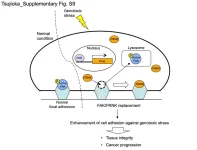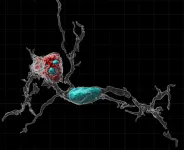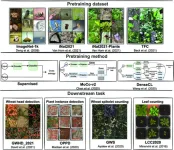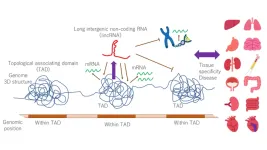(Press-News.org) ITHACA, N.Y. -- New research from a multidisciplinary team helps to illuminate the mechanisms behind circadian rhythms, offering new hope for dealing with jet lag, insomnia and other sleep disorders.
Using innovative cryo-electron microscopy techniques, the researchers have identified the structure of the circadian rhythm photosensor and its target in fruit flies (Drosophila melanogaster), one of the major organisms used to study circadian rhythms. The research, “Cryptochrome-Timeless Structure Reveals Circadian Clock Timing Mechanisms” published April 26 in Nature.
The research focused on fruit fly cryptochromes, key components of the circadian clocks of plants and animals, including humans. In flies and other insects, cryptochromes, activated by blue light, serve as the primary light sensors for setting circadian rhythms. The target of the cryptochrome photosensor, known as “Timeless” (TIM), is a large, complex protein that could not previously be imaged and thus its interactions with the cryptochrome are not well understood.
Circadian rhythms work via what are basically genetic feedback loops. The researchers found that the TIM protein, along with its partner, the Period (PER) protein, act together to inhibit the genes that are responsible for their own production. With suitable delays between the events of gene expression and repression, an oscillation in protein levels is established.
This oscillation represents the “the ticking of the clock and seems to be fairly unique to the circadian rhythm,” said senior author Brian Crane, the George W. and Grace L. Todd Professor and chair of chemistry and chemical biology in the College of Arts and Sciences.
Blue light, Crane said, changes the chemistry and structure of cryptochrome’s flavin cofactor, which allows the protein to bind the TIM protein and inhibit TIM’s ability to repress gene expression and thereby reset the oscillation.
Much of the hard work of the study went into figuring out how to produce the complex of cryptochrome-TIM so it could be studied, because TIM is such a large, unwieldy protein, Crane said. To achieve their results, first author Changfan Lin, M.S. ’17, Ph.D. ’21, modified the cryptochrome protein to improve the stability of the cryptochrome-TIM complex and used innovative techniques to purify the samples, making them suitable for high-resolution imaging.
“These new methods allowed us to obtain detailed images of the protein structures and gain valuable insights into their function, said Lin, a Friedrich's Ataxia Research Alliance Postdoctoral Fellow at the California Institute of Technology. “This research not only deepens our understanding of circadian rhythm regulation but also opens up new possibilities for developing therapies targeting related processes.”
Co-author Shi Feng, a doctoral student in the field of biophysics, did much of the cryo-electron microscopy work. Cristina C. DeOliveira, a doctoral student in the field of biochemistry and molecular and cell biology, was also a co-author.
One unexpected result from the study sheds light on how DNA damage is repaired in a cell. Cryptochromes are closely related to a family of enzymes involved in repairing damage to DNA, called photolyases. Crane said the research “explains why these families of proteins are closely related to each other, even though they're doing quite different things – they’re making use of the same molecular recognition in different contexts.”
The study also offers an explanation for the genetic variation of flies that allows them to adapt to higher latitudes, where days are shorter in the winter and it's cooler. These flies have more of a certain genetic variant that involves a change in the TIM protein, and it wasn’t clear why the variation could help them. The researchers found that because of how the cryptochrome binds TIM, the variation reduces the affinity of TIM for the cryptochrome. The interaction between the proteins is then modulated and the ability of light to reset the oscillation is changed, thus altering the circadian clock and extending the period of the fly’s dormancy, which helps it survive the winter.
“Some of the interactions that we see here in the fruit fly can be mapped onto human proteins,” Crane said. “This study may help us understand key interactions between components that regulate sleep behavior in people, such as how the critical delays in the basic timing mechanism get built into the system.”
Another exciting finding, said Lin, was the discovery of an important structural area in TIM, called the “groove,” which helps explain how TIM enters the cell nucleus. Previous studies had identified some factors involved in this process, but the exact mechanism remained unclear. “Our research provided a clearer understanding of this phenomenon,” Lin said.
-30-
END
New research sheds light on how circadian rhythms work
2023-04-26
ELSE PRESS RELEASES FROM THIS DATE:
Brain aging expert Ashley Webb, Ph.D. joins faculty at Buck Institute for Research on Aging
2023-04-26
The Buck Institute for Research on Aging announces that Ashley Webb, PhD, will join its faculty as an associate professor on August 1, 2023. Webb’s research is focused on the molecular mechanisms underlying stem cells and brain aging. She joins the Buck from Brown University, where she is currently an associate professor in the Department of Molecular Biology, Cell Biology and Biochemistry. Webb uses a combination of mouse models, cell culture approaches and genomics technologies to investigate the epigenetic and transcriptional mechanisms that preserve healthy ...
Study: Tree diversity increases storage of carbon and nitrogen in forest soils, mitigating climate change
2023-04-26
Preserving the diversity of forests assures their productivity and potentially increases the accumulation of carbon and nitrogen in the soil, which helps to sustain soil fertility and mitigate global climate change.
That's the main takeaway from a new study that analyzed data from hundreds of plots in Canada's National Forest Inventory to investigate the relationship between tree diversity and changes in soil carbon and nitrogen in natural forests.
Numerous biodiversity-manipulation experiments have collectively suggested that ...
Hanging on for dear life
2023-04-26
Researchers from Tokyo Medical and Dental University (TMDU) identify a novel mechanism by which cells adhere more strongly to their surrounding matrix in response to stress
Tokyo, Japan – The DNA molecules in our cells can be damaged by various extrinsic and intrinsic factors called genotoxic stressors; persistent and unchecked damage can lead to developing diseases like cancer. Fortunately, our cells don’t sit idly by and let this happen.
In a recent article published in Cell Death & Disease, a team ...
Immune system sculpts rat brains during development
2023-04-26
Researchers have established that biological sex plays a role in determining an individual’s risk of brain disorders. For example, boys are more likely to be diagnosed with behavioral conditions like autism or attention deficit disorder, whereas women are more likely to suffer from anxiety disorders, depression, or migraines. However, experts do not fully understand how sex contributes to brain development, particularly in the context of these diseases. They think, in part, it may have something to do with the differing sizes of certain brain regions.
University ...
One Health surveillance in Viet Nam highlights hotspots for viral disease emergence and calls for One Health action
2023-04-26
HA NOI, Viet Nam (April 26, 2023) – A new study led by the Wildlife Conservation Society (WCS) identified a viral hotspot in Viet Nam where bat roosting sites, bat guano harvesting, and pig farms are all in close proximity. The findings of this collaborative One Health study, described in the latest issue of the journal Viruses, have important implications for public health and wildlife conservation.
The authors say that the collection of guano – commonly used as a fertilizer – if not stopped ...
Breath test can monitor metabolism at home - study
2023-04-26
New research has found that it is possible to capture the impact of a meal on metabolism outside of a lab environment.
Published in the Journal of the International Society of Sports Nutrition and led by researchers at Anglia Ruskin University (ARU) in Cambridge, England, the study evaluated Lumen, which the manufacturers claim is the first device to allow people to monitor metabolic fuel use at home.
The research – the first applied study to investigate the practical use of this handheld breath device – was split into ...
Benchmarking deep-learning methods for more accurate plant-phenotyping
2023-04-26
In crop-breeding, plant phenotyping is the detailed study of a plant’s characteristic ‘visible’ or phenotypic features. It includes counting the number of plants generated by a crossing experiment and grading the features displayed by the offspring or progeny. The progeny with the desirable traits is then crossed to produce the next generation of crops, and the process is repeated to enhance the crop variety. Conventional methods for plant phenotyping typically lack scalability, accuracy, and are immensely labor-intensive. This imposes a certain bottleneck on crop-breeding programs.
However, with technological ...
UH-led research team seeks to improve language learning in bilingual children
2023-04-26
A University of Houston professor and her research team are seeking to improve the lives and education of bilingual children across the country through their research on developmental language disorder.
Anny Castilla-Earls, professor of communication sciences and disorders, was awarded $3.27 million for five years by the National Institute on Deafness and Other Communication Disorders to investigate the relationship between a child’s proficiency in English or Spanish and the language in which they receive treatment for developmental language disorder. Developmental language disorder, or ...
Astronomers image for the first time a black hole expelling a powerful jet
2023-04-26
An international team of scientists led by Dr. LU Rusen from the Shanghai Astronomical Observatory (SHAO) of the Chinese Academy of Sciences has used new millimeter-wavelength observations to produce an image that shows, for the first time, both the ring-like accretion structure around a black hole, where matter falls into the black hole, and the black hole's associated powerful relativistic jet. The source of the images was the central black hole of the prominent radio galaxy Messier 87.
The study was published in Nature on April 26.
The image underlines for the first time the connection between the accretion flow near the central supermassive black hole and the origin ...
LincRNA paints a target on diseased tissues
2023-04-26
Our genetic code includes over 15,000 specific sections that can be made into molecules called lincRNAs. Some of these sections can occur in coiled-up sections of our genome called TADs. LincRNAs derived from TADs appear to act as markers indicating the specific kind of tissue they are within. When something is wrong in these tissues, the markers could help with targeted medical interventions. The team that discovered this novel feature has outlined a way to apply this idea to different diseases and demonstrated it with a heart disease known as hypertrophic cardiomyopathy.
Diseases can affect very specific ...







